
Wine Culture and Information since 2002 - Volume 22
 Wine Culture and Information since 2002 - Volume 22 |
|
Contrasts of Albarossa and TempranilloItaly and Spain compared in the glasses of this month's tasting by contrast. The Italian grape is mainly cultivated in Piedmont, the Spanish one is protagonist in Rioja and Ribera del Duero wines |
|
This month in the glasses of our tasting by contrast we will be poured with wines produced in Italy and Spain. As usual, the two grapes – and therefore the wines – subject of our study have characteristics so different making them perfect for a comparison by contrast, therefore by highlighting the respective differences. Albarossa – which is experiencing a renewed interest from some producers in Piedmont – is a crossbreed created from the huge research activity by Prof. Giovanni Dalmasso. Tempranillo is undeniably one of the many wine glories of Spain, a variety being the protagonist of the important red wines of Rioja and Ribera del Duero. With a crisp and strong character and personality, Albarossa is perfectly opposed to the fuller structure and roundness of Tempranillo, a variety also characterized by a lower acidity. The Spanish variety, which has been quite successful even outside its land of origin, is rarely vinified alone. It should be noted that also in the two main areas where it is cultivated – Rioja and Ribera del Duero – Tempranillo is traditionally blended to other varieties, both indigenous and international. Albarossa, which is also vinified blended to other variety, is often used alone, making wines of certain interest and personality. It should be noted, in both cases, the two grapes are very often vinified in wood containers, rarely in inert containers. If for Albarossa the use of cask contributes to the balance of the appreciable acidity, in Tempranillo – having a much lower acidity – the reason is also dictated by traditional reasons. In Spain, in fact, red wines are often allowed to age in cask for long periods of time, a tradition strongly consolidated and having a long history.
|
|
Professor Giovanni Dalmasso, undoubtedly, has been of the most important researchers of Italian viticulture of the last century. The Piedmontese agronomist – who was born in Castagnole delle Lanze, in province of Asti – graduated at the Enological School of Alba and then taught viticulture and enology at the Enological School of Conegliano. Thanks to its important research and studies, he obtained – in 1938 – Albarossa variety by crossing Chatus and Barbera grapes. In reality, Giovanni Dalmasso believed he had crossed Nebbiolo and Barbera, however, subsequent studies on the genetic characteristics done on Albarossa have revealed this variety actually is a cross between Chatus and Barbera. The misunderstanding was caused by the name with which Chatus grape is known in Piedmont, here known as Nebbiolo di Dronero. This variety – it should be noted – has no connection with Nebbiolo and makes wines having evidently different characteristics. Giovanni Dalmasso's idea was to create a variety having the quality of Nebbiolo and the productivity of Barbera, in particular capable of having a better resistance against mould, powdery mildew and downy mildew. From a viticultural point of view, Albarossa is much closer to Barbera than to Chatus, it is a late ripening variety and the skin of its berries is rather thick. This variety has an appreciable quantity of anthocyanins, the wines produced with Albarossa therefore show very intense colors, often dark and deep, with evident nuances of purple color. From Barbera it has evidently acquired the typical acidity, a characteristic undeniably contributing to the character and personality of wines made from Albarossa grape. For this reason, together with the high content of sugars capable of producing a good quantity of alcohol, Albarossa is frequently aged in wood in order to get a better balance.
|
||||
|
Undisputed glory of Spanish red grapes, Tempranillo is the variety protagonist in red wines from Rioja and Ribera del Duero. In these two famous wine-growing areas of Spain, Tempranillo is the variety giving both structure and alcohol to red wines as well as the intense and dark color. Tempranillo has a moderate acidity and this is why producers blend it to other varieties in order to obtain a wine with a better balance. Grape of undeniable wine making value, Tempranillo has also been successful outside the borders of Spain, its homeland. This variety is in fact cultivated in many wine-growing countries of the world, including Italy, United States of America, Argentina, Chile and Australia. Even outside Spain, Tempranillo is often blended to other varieties, in particular with the so-called international grapes, as well as with local varieties. The name comes from the Spanish term `temprano” – meaning “early” and of which Tempranillo is diminutive – due to the characteristic of this grape to ripen a few weeks earlier than the other varieties. There is no reliable information about the origin of Tempranillo, however it is certain it is a very ancient variety. Viticulture in the Iberian Peninsula has been conducted since remote times and it is believed this variety was introduced by Phoenicians more than 3000 years ago. The difficulty in defining with certainty the origins of Tempranillo is also due to the scarcity of written documents and the first important mentions date back to the beginning of 1800s. Among the names with which Tempranillo is known in the Iberian Peninsula are mentioned: Cencibel, Tinto Fino, Tinta del Paķs, Tinta de Toro, Ull de llebre and Tinta Roriz. The latter is the name with which it is known in Portugal, where Tempranillo is also used for the production of the famous Port wine.
|
In this month's tasting by contrast, because of the typical wine making techniques used with Albarossa and Tempranillo, the wines subject to our study are aged in wood and with a few years of aging in bottle. The choice mainly depends on Tempranillo, which – besides being usually aged in cask – is marketed some years after harvesting. As for Albarossa, our choice is in favor of a wine produced in Piedmont – region where Albarossa is present – of course vinified as a mono varietal, and aged a few months in cask. The choice of Tempranillo is clearly more complex because its vinification as a mono varietal wine is not very common, so we need to pay attention in choosing the right bottle. Also in this case our choice is in favor of a wine aged for a few months in cask and released some years after harvesting. The two wines are tasted at a temperature of 18 °C (65 °F) and served in two tasting glasses. Let's pour Albarossa and Tempranillo into their respective glasses and start our tasting by contrast from the Piedmontese wine. The wines produced with these grapes are characterized by intense colors and low transparency, so it will be nuances and hues to make a difference. The color of Albarossa, observed at the base of the glass, held tilted over a white surface, reveals an intense and dark ruby red color, with a low transparency. Nuances, observed at the edge of the wine, towards the opening of the glass, show a ruby red color with evident and intense purple tones. Let's now pass to the evaluation of Tempranillo, holding the glass tilted over the white surface. The color, observed at the base of the wine, shows an intense and brilliant ruby red color with low transparency. Nuances of Tempranillo, observed at the edge of the wine, is characterized by an evident garnet red hue. The two grapes of our tasting by contrast have pretty different olfactory profiles, although in both cases the aromas recall red and black fruits, as well as flowers. In Albarossa will be the scents of red fruits to dominate the olfactory profile, in particular cherry, blueberry and raspberry. In this grape can also be perceived aromas of dark fruits, such as blackberry, black cherry and plum. Among the flowers which can be perceived in Albarossa, the most recurring ones are violet and cyclamen. The olfactory profile of Tempranillo is clearly oriented towards sensations of “riper fruits” dominated by black cherry, plum, blackberry, strawberry and blueberry. Among the olfactory sensations recalling flowers in Tempranillo we usually find violet. With the aging in wood, wines of both varieties are enriched with tertiary sensations – depending on time and type of cask – in particular tobacco, chocolate, licorice and leather. Let's now pass to the evaluation of the olfactory profiles of Albarossa and Tempranillo, starting from the wine produced in Piedmont. Hold the glass in vertical position and, without any swirling, do the first smell in order to evaluate the opening of Albarossa. From the glass can be perceived intense and pleasing aromas of black cherry, blueberry and plum as well as a pleasing aroma of violet. After having swirled the glass, let's proceed with the second smell that will complete the olfactory profile of Albarossa. From the glass will be perceived aromas of blackberry, raspberry, cyclamen, pomegranate and, depending on the wine making procedures, tertiary sensations as well. Let's now pass to the evaluation of the opening of Tempranillo, doing the first smell while holding the glass in vertical position and without swirling it. The glass reveals intense and clean aromas of black cherry, plum and blackberry, often combined with strawberry, especially in relatively young Tempranillo wines. After having swirled the glass, the profile of the Spanish grape is completed with blueberry and violet, as well as tertiary sensations given by the aging in wood. Let's proceed now to the evaluation of gustatory profiles, starting – just like the previous phases – from Albarossa. Let's take the first sip and evaluate the attack of the wine, that is the initial sensations produced in the mouth. You can perceive a pleasant crispness – typical in Albarossa and certainly inherited from Barbera – as well as a moderate astringency sensation produced by tannins. In the mouth are clearly perceived flavors of black cherry, blueberry and plum, confirming a good correspondence to the nose. The contribution of alcohol is evident, effective in balancing the acidity. Let's now pass to the evaluation of Tempranillo's attack, therefore take a sip of this wine. In the mouth can be perceived a very clear difference with Albarossa: the acidity is much lower, while roundness is more intense, also thanks to the contribution of alcohol, certainly not insignificant. Astringency is generally more intense than Albarossa and in the mouth can be perceived pleasing flavors of black cherry, blackberry, plum and strawberry. The final phase of our tasting by contrast is about the evaluation of the sensations left in the mouth by the wines after swallowing them. The finish of Albarossa is persistent, leaving in the mouth the pleasing freshness of acidity and a sensation of medium structure, in addition to the flavors of black cherry, blueberry and plum. Astringency is also moderate and roundness is less perceptible. The finish of Tempranillo, also in this case of good persistence, has a fuller structure, leaving in the mouth a more evident round sensation than Albarossa, with intense flavors of black cherry, plum, blackberry and strawberry. Let's now evaluate in succession the finish of the two wines, taking a sip of Albarossa first and then of Tempranillo, evaluating – in both cases – the sensations perceived after swallowing. The differences, especially in terms of acidity, roundness and structure are evident and decidedly contrasting.
|
||||||||
Wines of the Month |
|
|
|
Score legend Prices are to be considered as indicative. Prices may vary according to the country or the shop where wines are bought |

|
|
Montefalco Sagrantino Passito Colle Grimaldesco 2011 |
|
| Tabarrini (Umbria, Italy) | |
 Sagrantino Sagrantino | |
| Price: € 36.00 - 375ml | Score: |
 Deep ruby red and nuances of garnet red, little transparency. Deep ruby red and nuances of garnet red, little transparency. Intense, clean, pleasing, refined and elegant, starts with hints of
blackberry, black cherry and dried violet followed by aromas of plum,
blueberry, tamarind, tobacco, chocolate, pink pepper, vanilla, nail polish
and menthol. Intense, clean, pleasing, refined and elegant, starts with hints of
blackberry, black cherry and dried violet followed by aromas of plum,
blueberry, tamarind, tobacco, chocolate, pink pepper, vanilla, nail polish
and menthol.
 Sweet and tannic attack, however balanced by alcohol, full body,
intense flavors, pleasing roundness. Sweet and tannic attack, however balanced by alcohol, full body,
intense flavors, pleasing roundness.
 Persistent finish witl flavors of blackberry, black cherry and plum. Persistent finish witl flavors of blackberry, black cherry and plum. 36 months in barrique, 18 months in bottle. 36 months in barrique, 18 months in bottle. |
|
 Confectionery, Hard cheese, Fruit tarts, Chocolate desserts Confectionery, Hard cheese, Fruit tarts, Chocolate desserts |
|
|
|
|
Adarmando 2015 |
|
| Tabarrini (Umbria, Italy) | |
 Trebbiano Spoletino Trebbiano Spoletino | |
| Price: € 20.00 | Score: |
 Brilliant golden yellow color and nuances of golden yellow, very
transparent. Brilliant golden yellow color and nuances of golden yellow, very
transparent.
 Intense, clean, pleasing, refined and elegant, starts with hints of
apple, medlar and lychee followed by aromas of peach, citrus fruits, pear,
pineapple, hawthorn, plum, broom, melon, hazelnut and mineral. Intense, clean, pleasing, refined and elegant, starts with hints of
apple, medlar and lychee followed by aromas of peach, citrus fruits, pear,
pineapple, hawthorn, plum, broom, melon, hazelnut and mineral.
 Crisp attack and however balanced by alcohol, good body, intense
flavors, pleasing roundness. Crisp attack and however balanced by alcohol, good body, intense
flavors, pleasing roundness.
 Very persistent finish with long flavors of medlar, lychee and peach. Very persistent finish with long flavors of medlar, lychee and peach. At least 12 months in steel tanks, 6 months in bottle. At least 12 months in steel tanks, 6 months in bottle. |
|
 Stuffed pasta, Pasta and risotto with mushrooms and crustaceans, Roasted white meat, Stewed fish, Roasted fish Stuffed pasta, Pasta and risotto with mushrooms and crustaceans, Roasted white meat, Stewed fish, Roasted fish |
|
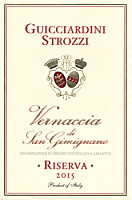
|
|
Vernaccia di San Gimignano Riserva 2015 |
|
| Guicciardini Strozzi (Tuscany, Italy) | |
 Vernaccia di San Gimignano Vernaccia di San Gimignano | |
| Price: € 11.50 | Score: |
 Intense straw yellow and nuances of straw yellow, very transparent. Intense straw yellow and nuances of straw yellow, very transparent. Intense, clean, pleasing and refined, starts with hints of apple, plum
and citrus fruits followed by aromas of pear, peach, jasmine, hawthorn,
pineapple, broom, almond and hints of vanilla. Intense, clean, pleasing and refined, starts with hints of apple, plum
and citrus fruits followed by aromas of pear, peach, jasmine, hawthorn,
pineapple, broom, almond and hints of vanilla.
 Crisp attack and however balanced by alcohol, good body, intense
flavors, agreeable. Crisp attack and however balanced by alcohol, good body, intense
flavors, agreeable.
 Persistent finish with flavors of apple, plum and almond. Persistent finish with flavors of apple, plum and almond. Some months in barrique, more than 12 months in bottle. Some months in barrique, more than 12 months in bottle. |
|
 Stuffed pasta, Roasted fish, Roasted white meat, Mushroom soups Stuffed pasta, Roasted fish, Roasted white meat, Mushroom soups |
|
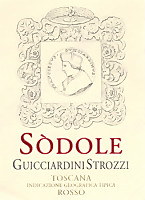
|
|
Sodole 2011 |
|
| Guicciardini Strozzi (Tuscany, Italy) | |
 Sangiovese Sangiovese | |
| Price: € 15.00 | Score: |
 Intense ruby red and nuances of garnet red, little transparency. Intense ruby red and nuances of garnet red, little transparency. Intense, clean, pleasing, refined and elegant, starts with hints of
black cherry, plum and violet followed by aromas of raspberry, chocolate,
tobacco, cinnamon, vanilla, mace and menthol. Intense, clean, pleasing, refined and elegant, starts with hints of
black cherry, plum and violet followed by aromas of raspberry, chocolate,
tobacco, cinnamon, vanilla, mace and menthol.
 Properly tannic attack and however balanced by alcohol, good body,
intense flavors, agreeable. Properly tannic attack and however balanced by alcohol, good body,
intense flavors, agreeable.
 Persistent finish with flavors of black cherry, plum and raspberry. Persistent finish with flavors of black cherry, plum and raspberry. 12 months in barrique, more than 12 months in bottle. 12 months in barrique, more than 12 months in bottle. |
|
 Carne alla griglia, Carne arrosto, Stufati e brasati di carne con funghi, Formaggi stagionati Carne alla griglia, Carne arrosto, Stufati e brasati di carne con funghi, Formaggi stagionati |
|
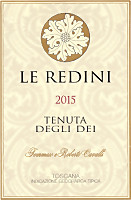
|
|
Le Redini 2015 |
|
| Tenuta degli Dei (Tuscany, Italy) | |
 Merlot (90%), Alicante (10%) Merlot (90%), Alicante (10%) | |
| Price: € 22.00 | Score: |
 Intense ruby red and nuances of ruby red, little transparency. Intense ruby red and nuances of ruby red, little transparency. Intense, clean, pleasing and refined, starts with hints of black
currant, black cherry and plum followed by aromas of violet, blueberry,
blackberry, geranium, chocolate, pink pepper and vanilla. Intense, clean, pleasing and refined, starts with hints of black
currant, black cherry and plum followed by aromas of violet, blueberry,
blackberry, geranium, chocolate, pink pepper and vanilla.
 Properly tannic attack and however balanced by alcohol, good body,
intense flavors, pleasing roundness. Properly tannic attack and however balanced by alcohol, good body,
intense flavors, pleasing roundness.
 Persistent finish with flavors of black currant, black cherry and plum. Persistent finish with flavors of black currant, black cherry and plum. 10 months in barrique and cask, 6 months in bottle. 10 months in barrique and cask, 6 months in bottle. |
|
 Broiled meat and barbecue, Roasted meat, Stewed meat, Hard cheese Broiled meat and barbecue, Roasted meat, Stewed meat, Hard cheese |
|
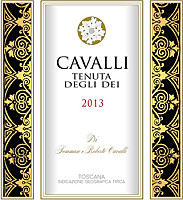
|
|
Cavalli 2013 |
|
| Tenuta degli Dei (Tuscany, Italy) | |
 Cabernet Sauvignon (50%), Cabernet Franc (35%), Petit Verdot (15%) Cabernet Sauvignon (50%), Cabernet Franc (35%), Petit Verdot (15%) | |
| Price: € 45.00 | Score: |
 Intense ruby red and nuances of garnet red, little transparency. Intense ruby red and nuances of garnet red, little transparency. Intense, clean, pleasing, refined and elegant, starts with hints of
black currant, black cherry and plum followed by aromas of violet,
blueberry, peony, blackberry, bell pepper, cocoa, face powder, tobacco,
pink pepper, vanilla and eucalyptus. Intense, clean, pleasing, refined and elegant, starts with hints of
black currant, black cherry and plum followed by aromas of violet,
blueberry, peony, blackberry, bell pepper, cocoa, face powder, tobacco,
pink pepper, vanilla and eucalyptus.
 Properly tannic attack and however balanced by alcohol, full body,
intense flavors, agreeable. Properly tannic attack and however balanced by alcohol, full body,
intense flavors, agreeable.
 Persistent finish with flavors of black currant, black cherry and
blueberry. Persistent finish with flavors of black currant, black cherry and
blueberry.
 18 months in barrique and cask, 18 months in bottle. 18 months in barrique and cask, 18 months in bottle. |
|
 Game, Roasted meat, Stewed and braised meat, Hard cheese Game, Roasted meat, Stewed and braised meat, Hard cheese |
|

|
|
A Sirio 2013 |
|
| Sangervasio (Tuscany, Italy) | |
 Sangiovese Sangiovese | |
| Price: € 20.00 | Score: |
 Brilliant ruby red and nuances of garnet red, moderate transparency. Brilliant ruby red and nuances of garnet red, moderate transparency. Intense, clean, pleasing, refined and elegant, starts with hints of
black cherry, plum and dried violet followed by aromas of raspberry,
blackberry, dried rose, tobacco, rhubarb, cocoa, vanilla, mace and menthol. Intense, clean, pleasing, refined and elegant, starts with hints of
black cherry, plum and dried violet followed by aromas of raspberry,
blackberry, dried rose, tobacco, rhubarb, cocoa, vanilla, mace and menthol.
 Properly tannic attack and however balanced by alcohol, good body,
intense flavors, agreeable. Properly tannic attack and however balanced by alcohol, good body,
intense flavors, agreeable.
 Persistent finish with flavors of black cherry, plum and raspberry. Persistent finish with flavors of black cherry, plum and raspberry. 14 months in barrique, 24 months in bottle. 14 months in barrique, 24 months in bottle. |
|
 Roasted meat, Broiled meat and barbecue, Stewed meat with mushrooms, Hard cheese Roasted meat, Broiled meat and barbecue, Stewed meat with mushrooms, Hard cheese |
|
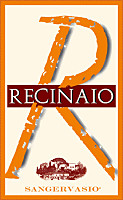
|
|
Colli dell'Etruria Centrale Vin Santo Recinaio 2005 |
|
| Sangervasio (Tuscany, Italy) | |
 Trebbiano Toscano (70%), San Colombano (15%), Sangiovese (15%) Trebbiano Toscano (70%), San Colombano (15%), Sangiovese (15%) | |
| Price: € 30.00 - 375ml | Score: |
 Deep amber yellow and nuances of amber yellow, moderate transparency. Deep amber yellow and nuances of amber yellow, moderate transparency. Intense, clean, pleasing, refined and elegant, starts with hints of
raisin, dried fig and caramel followed by aromas of honey, quince jam,
walnut husk, coffee, tobacco, citrus fruit peel, almond, licorice, leather,
vanilla and nail polish. Intense, clean, pleasing, refined and elegant, starts with hints of
raisin, dried fig and caramel followed by aromas of honey, quince jam,
walnut husk, coffee, tobacco, citrus fruit peel, almond, licorice, leather,
vanilla and nail polish.
 Sweet and round attack, however balanced by alcohol, full body, intense
flavors, pleasing crispness. Sweet and round attack, however balanced by alcohol, full body, intense
flavors, pleasing crispness.
 Persistent finish with long flavors of raisin, dried fig and honey. Persistent finish with long flavors of raisin, dried fig and honey. At least 8 years in small barrels (caratelli), 12 months in bottle. At least 8 years in small barrels (caratelli), 12 months in bottle. |
|
 Jam and chocolate tarts, Hard and piquant cheese Jam and chocolate tarts, Hard and piquant cheese |
|
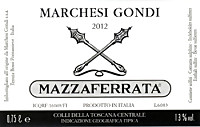
|
|
Mazzaferrata 2012 |
|
| Marchesi Gondi - Tenuta Bossi (Tuscany, Italy) | |
 Cabernet Sauvignon Cabernet Sauvignon | |
| Price: € 40.00 | Score: |
 Intense ruby red and nuances of garnet red, little transparency. Intense ruby red and nuances of garnet red, little transparency. Intense, clean, pleasing, refined and elegant, starts with hints of
black currant, black cherry and plum followed by aromas of violet,
blueberry, blackberry, bell pepper, vanilla, cocoa, tobacco, leather and
eucalyptus. Intense, clean, pleasing, refined and elegant, starts with hints of
black currant, black cherry and plum followed by aromas of violet,
blueberry, blackberry, bell pepper, vanilla, cocoa, tobacco, leather and
eucalyptus.
 Tannic attack and however balanced by alcohol, full body, intense
flavors, agreeable. Tannic attack and however balanced by alcohol, full body, intense
flavors, agreeable.
 Persistent finish with flavors of black currant, plum and black cherry. Persistent finish with flavors of black currant, plum and black cherry. 12 months in cask, 12 months in barrique, 24 months in bottle. 12 months in cask, 12 months in barrique, 24 months in bottle. |
|
 Game, Roasted meat, Stewed and braised meat, Hard cheese Game, Roasted meat, Stewed and braised meat, Hard cheese |
|
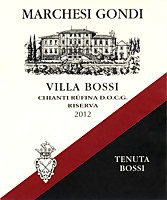
|
|
Chianti Rufina Riserva Villa Bossi 2012 |
|
| Marchesi Gondi - Tenuta Bossi (Tuscany, Italy) | |
 Sangiovese (80%), Colorino (10%), Cabernet Sauvignon (10%) Sangiovese (80%), Colorino (10%), Cabernet Sauvignon (10%) | |
| Price: € 40.00 | Score: |
 Intense ruby red and nuances of garnet red, little transparency. Intense ruby red and nuances of garnet red, little transparency. Intense, clean, pleasing, refined and elegant, starts with hints of
black cherry, plum and black currant followed by aromas of dried violet,
blueberry, blackberry, cocoa, tobacco, vanilla, licorice, leather, mace and
menthol. Intense, clean, pleasing, refined and elegant, starts with hints of
black cherry, plum and black currant followed by aromas of dried violet,
blueberry, blackberry, cocoa, tobacco, vanilla, licorice, leather, mace and
menthol.
 Properly tannic attack and however balanced by alcohol, good body,
intense flavors, agreeable. Properly tannic attack and however balanced by alcohol, good body,
intense flavors, agreeable.
 Persistent finish with flavors of black cherry, plum and blackberry. Persistent finish with flavors of black cherry, plum and blackberry. 12 months in barrique, 12 months in bottle. 12 months in barrique, 12 months in bottle. |
|
 Roasted meat, Broiled meat and barbecue, Stewed and braised meat with mushrooms, Hard cheese Roasted meat, Broiled meat and barbecue, Stewed and braised meat with mushrooms, Hard cheese |
|
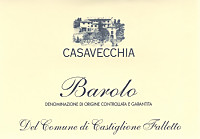
|
|
Barolo Piantà 2010 |
|
| Casavecchia (Piedmont, Italy) | |
 Nebbiolo Nebbiolo | |
| Price: € 26.20 | Score: |
 Brilliant ruby red and nuances of garnet red, little transparency. Brilliant ruby red and nuances of garnet red, little transparency. Intense, clean, pleasing, refined and elegant, starts with hints of
cherry, plum and dried violet followed by aromas of raspberry, dried rose,
leather, anise, licorice, cocoa, tobacco, cinnamon, vanilla, mace and
menthol. Intense, clean, pleasing, refined and elegant, starts with hints of
cherry, plum and dried violet followed by aromas of raspberry, dried rose,
leather, anise, licorice, cocoa, tobacco, cinnamon, vanilla, mace and
menthol.
 Tannic attack and however balanced by alcohol, full body, intense
flavors, pleasing crispness. Tannic attack and however balanced by alcohol, full body, intense
flavors, pleasing crispness.
 Persistent finish with flavors of cherry, plum and raspberry. Persistent finish with flavors of cherry, plum and raspberry. 2 years in cask, at least 18 months in bottle. 2 years in cask, at least 18 months in bottle. |
|
 Game, Roasted meat, Stewed and braised meat, Hard cheese Game, Roasted meat, Stewed and braised meat, Hard cheese |
|
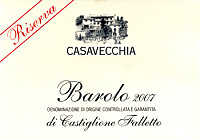
|
|
Barolo Riserva del Comune di Castiglione Falletto 2007 |
|
| Casavecchia (Piedmont, Italy) | |
 Nebbiolo Nebbiolo | |
| Price: € 30.30 | Score: |
 Intense ruby red and nuances of garnet red, little transparency. Intense ruby red and nuances of garnet red, little transparency. Intense, clean, pleasing, refined and elegant, starts with hints of
cherry jam, plum jam and dried violet followed by aromas of strawberry jam,
blueberry jam, cocoa, tobacco, dried rose, cinnamon, licorice, leather,
rhubarb, vanilla and menthol. Intense, clean, pleasing, refined and elegant, starts with hints of
cherry jam, plum jam and dried violet followed by aromas of strawberry jam,
blueberry jam, cocoa, tobacco, dried rose, cinnamon, licorice, leather,
rhubarb, vanilla and menthol.
 Tannic attack and however balanced by alcohol, full body, intense
flavors, pleasing crispness and roundness. Tannic attack and however balanced by alcohol, full body, intense
flavors, pleasing crispness and roundness.
 Persistent finish with flavors of plum jam, cherry jam and strawberry
jam. Persistent finish with flavors of plum jam, cherry jam and strawberry
jam.
 2 years in cask, at least 18 months in bottle. 2 years in cask, at least 18 months in bottle. |
|
 Game, Roasted meat, Stewed and braised meat, Hard cheese Game, Roasted meat, Stewed and braised meat, Hard cheese |
|
|
||||||||
|
DiWineTaste Polls
|
| |||||||
Privacy Policy | |||||||


| Copyright © 2002-2024 Antonello Biancalana, DiWineTaste - All rights reserved |
| All rights reserved under international copyright conventions. No part of this publication and of this WEB site may be
reproduced or utilized in any form or by any means, electronic or mechanical, without permission in writing from DiWineTaste. |